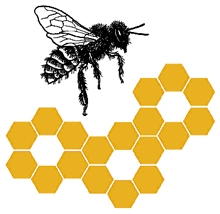The queen and workers are female bees with a diploid set of chromosomes. The drones are male with a haploid set of chromosomes. To get a worker, the queen must add sperm to the egg. There must be a male to provide that sperm. To get a male, she does nothing but deposit the egg in a cell. No sperm in needed from a male bee. – Ed Beary…
How are queen bees raised and mated?
There are many methods of raising queen bees, but the central tenant of queen production is that a fertilized egg may be reared into a queen or worker depending on the food it receives as a larva. In general, a beekeeper specializing in queen production sets up special colonies (e.g., “starter” colonies) that are queenless. Young larvae are transferred, or “grafted,” from selected breeder colonies into man-made queen cell cups. The grafted larvae are placed into the starter colony where …
Can a honey bee be born without the aid of a drone?
Yes and no. A drone’s (male bee) purpose is to mate with a queen (female reproductive bee). All other colony activities are performed by worker bees (female bees). To discuss how a bee is born, we can start with when the egg is laid. Generally speaking, if the queen fertilizes this egg with sperm, it will become a worker bee, or another queen. If she does not fertilize the egg, it will become a drone (male). The care and feeding …
Honey Bee Genetic Diversity and Breeding: Towards the Reintroduction of European Germplasm

A National Research and Extension Initiative to Reverse Pollinator Decline
This is part of an ongoing series of updates from the Managed Pollinator CAP. Additional installments can be found at the:
More information about the CAP can be found at:
by Walter S. Sheppard, Washington State University
CAP Updates: 24
- Jointly published in the American Bee Journal and in Bee Culture, February 2012.
As we reflect …
The Managed Pollinator CAP after Three Years: Highlights and Emerging Trends

A National Research and Extension Initiative to Reverse Pollinator Decline
This is part of an ongoing series of updates from the Managed Pollinator CAP. Additional installments can be found at the:
More information about the CAP can be found at:

Keith S. Delaplane, Professor and CAP Director, University of Georgia
by Keith S. Delaplane, Professor and CAP Director, University of Georgia
CAP Updates: 23
- Jointly published in
An Update on Bee Breeding Efforts in Indiana: Breeding for Resistance to Israeli Acute Paralysis Virus

A National Research and Extension Initiative to Reverse Pollinator Decline
This is part of an ongoing series of updates from the Managed Pollinator CAP. Additional installments can be found at the:
More information about the CAP can be found at:
by Greg Hunt, Dave Shenefield, Krispn Given, and Jennifer Tsuruda
CAP Updates: 21
- Jointly published in the American Bee Journal and in Bee Culture, November 2011.
Laying Groundwork for a Sustainable Market of Genetically-Improved Queens: The Bee Team
Download a .pdf of this article here

A National Research and Extension Initiative to Reverse Pollinator Decline
This is part of an ongoing series of updates from the Managed Pollinator CAP. Additional installments can be found at the:
More information about the CAP can be found at:
CAP Updates: 16
Marla Spivak, University of Minnesota
- Jointly published in the American Bee Journal and in Bee Culture,
How many times does a queen honey bee mate?
A queen mates during the first 1-2 weeks of her adult life. She can take multiple mating flights and mated with several males – on average 12-15. Increasing the genetic diversity of the colony is important for colony productivity and disease resistance.
– Christina Grozinger, Pennsylvania State University…
What is the best way to introduce a queen into a colony?
It is best to introduce a new queen into a small colony, such as a recent divide or nuc (nucleus colony). Young bees accept new queens more readily than old bees, so it is best to make a divide, allow the old foragers to return to the parent colony and let the divide sit queenless for 24 hours. A caged, new queen is introduced into the queenless colony. The queen should remain in the cage for 3 days before she …
Selecting for Varroa Sensitive Hygiene
For a description of the VSH trait in honey bees, please see Varroa Sensitive Hygiene and Mite Reproduction.
The USDA-ARS Baton Rouge Bee Lab has bred bees that express Varroa Sensitive Hygiene, and we would like to offer a simple technique that queen breeders could use to select for VSH. However, there is no method at this time that is both easy and accurate. We have developed several types of measurement, but the most accurate require significant time at …
